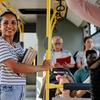
The pandemic laid bare and exacerbated long-standing social inequities and disparities. From healthcare and housing to education and childcare, we’re still seeing the scars of a national political failure to address basic needs insecurity. This shouldn’t be a surprise—the incentive structures in the U.S. economy reward the accumulation of resources instead of equitably distributing them.
Over the last few years, there’s been something of a social reawakening oriented toward securing those basic needs and a growing interest in how the structure of society makes that so difficult. I’ve noticed this through a surge of urban planning content around the internet, with some YouTube channels racking up over a million subscribers.
Transportation planner turned YouTuber Ray Delahanty runs one of those channels. Delahanty lives in Albuquerque and makes content full-time for his channel CityNerd.
Corners of the web like Delahanty’s speak to what too often feels like a revelation: our world actually could be organized in such a way that not only meets everyone’s basic needs—but is also enjoyable to live in.
We sat down with Delahanty to try to imagine what that better world could look like for college students.
In our last survey, we found that almost half of students experience housing insecurity. Due to socio-economic indicators, community college students are often disproportionately affected. What, from your urban-planning perspective, contributes to that vast housing insecurity?
I spent a little time in community college myself—what’s obviously different is that they’re mostly commuter colleges. When you’re dealing with a four-year university, often students are living in university student housing. It’s not cheap, but you can roll it into your student loan. That’s not necessarily a great situation, but you’re not housing insecure. You’re delaying the monetary burden until you have a job, but at least you don’t have that stress hanging over you while you’re trying to get an education and preparing to enter the workforce.
Community colleges generally don’t have student housing—a lot of students are going half-time while they’re working full-time, and many are working full-time while attending full-time. They’re likely not working a high-income job. Particularly with community colleges in more expensive coastal cities, that all isn’t going to add up. The housing that you’re competing for is more expensive than it would be in St. Louis or Cleveland.
It's a big problem for people who couldn’t or wouldn’t or didn’t have the resources to go to a four-year school, stay in student housing, and attend full-time.
How do we advocate for city planners and other authorities to work on meeting student transportation needs?
There are things that cities and transportation agencies and whichever other agencies are involved can do.
This isn’t community college, but I always think of the programs at The University of Washington, where I went, which is kind of a leader in transportation demand management (TDM). They’ve had this program for a very long time called U-Pass. Essentially, as part of your student body card or your student union card, it includes a free pass for all of the transit in the whole region—light rail, buses, even the water taxi.
The way that pencils out, I think, from the university’s perspective is a decreased need for parking, which means that they can then use that acreage to add another building where they offer more classes and increase the school’s capacity and meet other needs.
From the perspective of the city and the transit agencies, it’s good because you’re keeping cars off the road which helps them move in the right direction on their climate objectives and traffic goals.
All of those are great reasons to give this population—which probably doesn’t have much money and is mostly going to be tied to a campus—support. It’s a win all the way around. You see that at a lot of other universities, but I don’t think community colleges have adopted it—which is kind of ridiculous, right?
There’s an issue of equity there. If your social services or your city’s amenities—or even private things like the grocery store— are organized around driving to access them you’re really disadvantaging the people who can’t afford a car.

Ray Delahanty
Urban Planner
The other piece of that—and I believe this is part of the philosophy—is that a significant among of the college population is at a younger, malleable age where they’re starting to dial in certain behaviors about how they get around a city. If you’re encouraged to take the bus or take heavy rail like SEPTA [Philadelphia’s major transit provider] to school and be in the habit of that—that’s a good thing long term. You’re then more likely to take it even when you start working and can “afford a car.” You might be in the habit of taking transit first, which is honestly good for everybody.
All those pieces kind of fit together when you think about what the city can do, and what transit agencies can do, to help ease the burden of at least the transportation part on students.
We did a study on a U-Pass program at Rio Hondo College and found that it worked incredibly well.
I would love to hear you talk more about the development of social habits and how that might affect the ability of cities to meet people’s needs if infrastructure was, say, less car-centric.
There’s an issue of equity there. If your social services or your city’s amenities—or even private things like the grocery store— are organized around driving to access them you’re really disadvantaging the people who can’t afford a car.
People should have the choice not to have to drive. Owning, operating and maintaining a car is a burden.
Housing and transportation are inseparable. Where you live and where you have to go every day determines what your transportation needs are.
It should be possible for people to live as free of a car as they possibly can—if nothing else, to ease that part of their budget—and because of how volatile the housing market is. If you’re a renter, there’s no guarantee of what your rent is going to be next year. It could go up 50%; you don’t even know. Having the ability to lock in something very reasonable for your transportation and having the things you need to do every day in transit is a big win for a city overall.
It's important for things like equity and levelling the playing field.
It’s a matter of taking care of all of the people in the city and making sure everybody can access the services they need to without placing a huge burden on their housing and transportation budget.
I love that answer—especially because of how equity-forward basic needs work necessarily has to be.
Yeah, it is—there are all kinds of agencies and non-profits that are specifically there to serve people who are either below the poverty line or at-risk somehow, and those are the people who are less likely to be able to afford to drive somewhere. They go hand in hand.
This is the thing we see a lot of the time with transport issues in college. It’s not “I can’t get to my college”, it’s, “I can’t get to college AND get my kid to daycare AND do all this stuff because it’s all in different places.”
Yeah, and it’s not a black and white issue either. It’s not always the matter of affording a car or not, it’s grey. It’s a question of how much of a hardship it is for you to own and operate and maintain a car and that answer varies. For some people it’s not a hardship at all—they might have plenty of income or an inheritance or rich parents or whatever.
Housing and transportation are inseparable. Where you live and where you have to go every day determines what your transportation needs are. It should be possible for people to live as free of a car as they possibly can—if nothing else, to ease that part of their budget—and because of how volatile the housing market is.

Ray Delahanty
Urban Planner
There’s a middle ground of, “I’d rather not have a car. I kind of hate driving and it’s a suck on my budget, but given the transit options I don’t have a choice.” That’s not a situation we should be putting anybody in—particularly in an urban college environment. If it’s a college in a small town maybe it’s not easy to fix, but in an urban environment like Philly or other US cities, we need not be in that situation. The transit options should be there to take care of the vast majority of your daily needs.
If you could do one thing, change one law or policy, to support transport for students facing basic needs insecurity, what would it be?
I struggle with questions like that because there are so many things, and I like to be realistic.
There are places that have made the effective argument for making transit free in particular while improving the quality of transit.
It’s the same idea as giving scholarships—right? There’s an endowment or some sort of financial thing the university does to have it pencil out. Why not have a transportation version of a scholarship except you give it to everybody? That’s what I would want to see at the community college level.
I would like to see good transportation service to community colleges that help you get where you need to go. At least, if nothing else, you’ve eased that part of the burden on people’s budgets. Start there.
I’d love to see stuff re-zoned around schools, too, but that’s a tougher one.
One other thing you often bring up —especially when talking about college towns—is that these places have centers of walkability that make it possible for people to live meaningfully day-to-day without a car.
How do we encourage areas around community colleges—or other places where people are likely to face basic needs insecurity—to function more like that?
It’s a clear and natural evolution for a four-year university because you have this captive population of sometimes up to thirty-thousand people—it might almost be a city unto itself—so you need a retail district and services there.
It makes sense, I think, for urban two-year colleges because even though you don’t have that captive audience 24 hours a day, you have it for 12-16 hours a day because of evening classes.
You’ve got an area where there’s a lot of foot traffic all day long. There’s almost always a summer session.
It makes sense to think about how the area is zoned. For instance, is it all single-family residential? It would really make a lot more sense to allow more mixed-zoning uses around a place where you have people that come there every day.
It’s like what you talked about—you’re not just going from one place to one other place, you’re usually trip-chaining. You’ve got a couple things to do. And boy, would it be nice if all of those things were in the same place.
A community college is a much more viable place to put those services and amenities than, say, your typical development where an industry clears a huge parcel of land for mixed-use. You can understand why it happens—you’ve got this big opportunity site to draw people to, but you’ve got to invent all that. But with a community college you’ve already got this built-in population of people who need these services
There are a lot of businesses that would probably be interested in being in a place where there’s naturally a lot of people coming and going—unlike an empty lot or the middle of a residential area.
The average age of college students has increased significantly. The number of students older than 25 is inching toward 1/3 of all college students. A fifth of students in college are raising a kid.
That only makes your proposition stronger because that space could be used for things these folks need and businesses want them to pay for. That space could be a child care center or, a grocery store.
Colleges are natural social environments too, right? It’s where you meet people who are interested in the same things that you’re interested in because they chose to take the same classes you’re taking. You find overlap in things that you enjoy doing and things you want to advocate for.
It feels like such a cool two birds one stone situation—we now have an obvious place for businesses to move in, and we're fixing a transportation need—just by things being closer.
People have to go to a lot of different places and the more you can make it so all those places are in the same place, the easier you make life for everybody.
It touches on climate, and it touches on quality-of-life. You get to spend time doing what you want instead of driving from place to place.
Making life more enjoyable does seem to get left out of the conversation.
It’s kind of the reason you get into public service in the first place. It’s for your community. That always seems to get lost in some way or another.
It’s life, liberty, and the pursuit of happiness. That’s like, the most basic stuff, right?


